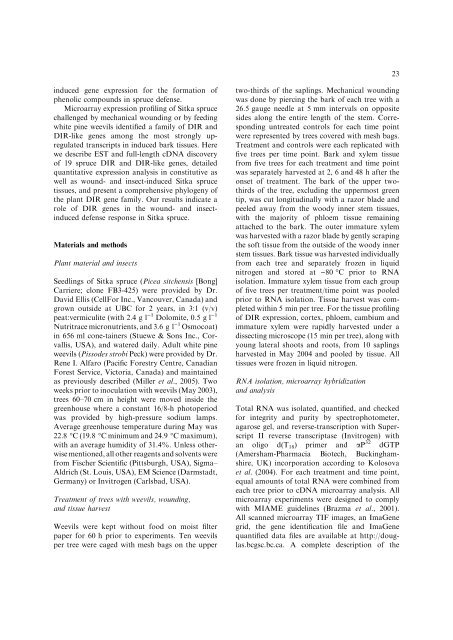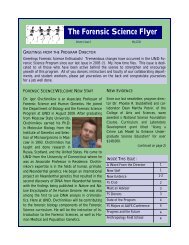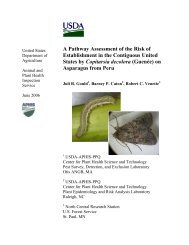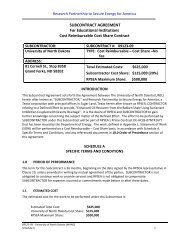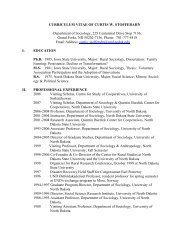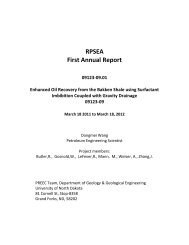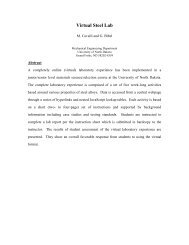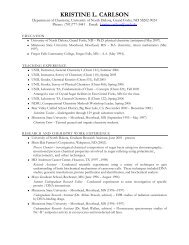Dirigent proteins in conifer defense: gene discovery, phylogeny, and ...
Dirigent proteins in conifer defense: gene discovery, phylogeny, and ...
Dirigent proteins in conifer defense: gene discovery, phylogeny, and ...
Create successful ePaper yourself
Turn your PDF publications into a flip-book with our unique Google optimized e-Paper software.
23<br />
<strong>in</strong>duced <strong>gene</strong> expression for the formation of<br />
phenolic compounds <strong>in</strong> spruce <strong>defense</strong>.<br />
Microarray expression profil<strong>in</strong>g of Sitka spruce<br />
challenged by mechanical wound<strong>in</strong>g or by feed<strong>in</strong>g<br />
white p<strong>in</strong>e weevils identified a family of DIR <strong>and</strong><br />
DIR-like <strong>gene</strong>s among the most strongly upregulated<br />
transcripts <strong>in</strong> <strong>in</strong>duced bark tissues. Here<br />
we describe EST <strong>and</strong> full-length cDNA <strong>discovery</strong><br />
of 19 spruce DIR <strong>and</strong> DIR-like <strong>gene</strong>s, detailed<br />
quantitative expression analysis <strong>in</strong> constitutive as<br />
well as wound- <strong>and</strong> <strong>in</strong>sect-<strong>in</strong>duced Sitka spruce<br />
tissues, <strong>and</strong> present a comprehensive <strong>phylogeny</strong> of<br />
the plant DIR <strong>gene</strong> family. Our results <strong>in</strong>dicate a<br />
role of DIR <strong>gene</strong>s <strong>in</strong> the wound- <strong>and</strong> <strong>in</strong>sect<strong>in</strong>duced<br />
<strong>defense</strong> response <strong>in</strong> Sitka spruce.<br />
Materials <strong>and</strong> methods<br />
Plant material <strong>and</strong> <strong>in</strong>sects<br />
Seedl<strong>in</strong>gs of Sitka spruce (Picea sitchensis [Bong]<br />
Carriere; clone FB3-425) were provided by Dr.<br />
David Ellis (CellFor Inc., Vancouver, Canada) <strong>and</strong><br />
grown outside at UBC for 2 years, <strong>in</strong> 3:1 (v/v)<br />
peat:vermiculite (with 2.4 g l )1 Dolomite, 0.5 g l )1<br />
Nutritrace micronutrients, <strong>and</strong> 3.6 g l )1 Osmocoat)<br />
<strong>in</strong> 656 ml cone-ta<strong>in</strong>ers (Stuewe & Sons Inc., Corvallis,<br />
USA), <strong>and</strong> watered daily. Adult white p<strong>in</strong>e<br />
weevils (Pissodes strobi Peck) were provided by Dr.<br />
Rene I. Alfaro (Pacific Forestry Centre, Canadian<br />
Forest Service, Victoria, Canada) <strong>and</strong> ma<strong>in</strong>ta<strong>in</strong>ed<br />
as previously described (Miller et al., 2005). Two<br />
weeks prior to <strong>in</strong>oculation with weevils (May 2003),<br />
trees 60–70 cm <strong>in</strong> height were moved <strong>in</strong>side the<br />
greenhouse where a constant 16/8-h photoperiod<br />
was provided by high-pressure sodium lamps.<br />
Average greenhouse temperature dur<strong>in</strong>g May was<br />
22.8 °C (19.8 °C m<strong>in</strong>imum <strong>and</strong> 24.9 °C maximum),<br />
with an average humidity of 31.4%. Unless otherwise<br />
mentioned, all other reagents <strong>and</strong> solvents were<br />
from Fischer Scientific (Pittsburgh, USA), Sigma–<br />
Aldrich (St. Louis, USA), EM Science (Darmstadt,<br />
Germany) or Invitrogen (Carlsbad, USA).<br />
Treatment of trees with weevils, wound<strong>in</strong>g,<br />
<strong>and</strong> tissue harvest<br />
Weevils were kept without food on moist filter<br />
paper for 60 h prior to experiments. Ten weevils<br />
per tree were caged with mesh bags on the upper<br />
two-thirds of the sapl<strong>in</strong>gs. Mechanical wound<strong>in</strong>g<br />
was done by pierc<strong>in</strong>g the bark of each tree with a<br />
26.5 gauge needle at 5 mm <strong>in</strong>tervals on opposite<br />
sides along the entire length of the stem. Correspond<strong>in</strong>g<br />
untreated controls for each time po<strong>in</strong>t<br />
were represented by trees covered with mesh bags.<br />
Treatment <strong>and</strong> controls were each replicated with<br />
five trees per time po<strong>in</strong>t. Bark <strong>and</strong> xylem tissue<br />
from five trees for each treatment <strong>and</strong> time po<strong>in</strong>t<br />
was separately harvested at 2, 6 <strong>and</strong> 48 h after the<br />
onset of treatment. The bark of the upper twothirds<br />
of the tree, exclud<strong>in</strong>g the uppermost green<br />
tip, was cut longitud<strong>in</strong>ally with a razor blade <strong>and</strong><br />
peeled away from the woody <strong>in</strong>ner stem tissues,<br />
with the majority of phloem tissue rema<strong>in</strong><strong>in</strong>g<br />
attached to the bark. The outer immature xylem<br />
was harvested with a razor blade by gently scrap<strong>in</strong>g<br />
the soft tissue from the outside of the woody <strong>in</strong>ner<br />
stem tissues. Bark tissue was harvested <strong>in</strong>dividually<br />
from each tree <strong>and</strong> separately frozen <strong>in</strong> liquid<br />
nitrogen <strong>and</strong> stored at )80 °C prior to RNA<br />
isolation. Immature xylem tissue from each group<br />
of five trees per treatment/time po<strong>in</strong>t was pooled<br />
prior to RNA isolation. Tissue harvest was completed<br />
with<strong>in</strong> 5 m<strong>in</strong> per tree. For the tissue profil<strong>in</strong>g<br />
of DIR expression, cortex, phloem, cambium <strong>and</strong><br />
immature xylem were rapidly harvested under a<br />
dissect<strong>in</strong>g microscope (15 m<strong>in</strong> per tree), along with<br />
young lateral shoots <strong>and</strong> roots, from 10 sapl<strong>in</strong>gs<br />
harvested <strong>in</strong> May 2004 <strong>and</strong> pooled by tissue. All<br />
tissues were frozen <strong>in</strong> liquid nitrogen.<br />
RNA isolation, microarray hybridization<br />
<strong>and</strong> analysis<br />
Total RNA was isolated, quantified, <strong>and</strong> checked<br />
for <strong>in</strong>tegrity <strong>and</strong> purity by spectrophotometer,<br />
agarose gel, <strong>and</strong> reverse-transcription with Superscript<br />
II reverse transcriptase (Invitrogen) with<br />
an oligo d(T 18 ) primer <strong>and</strong> aP 32 dGTP<br />
(Amersham-Pharmacia Biotech, Buck<strong>in</strong>ghamshire,<br />
UK) <strong>in</strong>corporation accord<strong>in</strong>g to Kolosova<br />
et al. (2004). For each treatment <strong>and</strong> time po<strong>in</strong>t,<br />
equal amounts of total RNA were comb<strong>in</strong>ed from<br />
each tree prior to cDNA microarray analysis. All<br />
microarray experiments were designed to comply<br />
with MIAME guidel<strong>in</strong>es (Brazma et al., 2001).<br />
All scanned microarray TIF images, an ImaGene<br />
grid, the <strong>gene</strong> identification file <strong>and</strong> ImaGene<br />
quantified data files are available at http://douglas.bcgsc.bc.ca.<br />
A complete description of the


